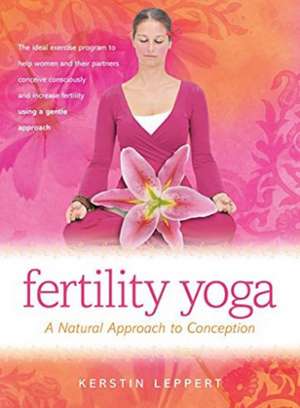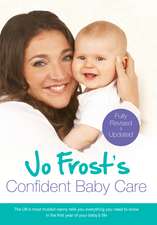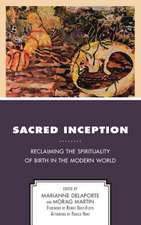Fertility Yoga: A Natural Approach to Conception
Autor Kerstin Lepperten Limba Engleză Paperback – 9 sep 2013
Preț: 100.59 lei
Nou
Puncte Express: 151
Preț estimativ în valută:
19.25€ • 20.15$ • 15.93£
19.25€ • 20.15$ • 15.93£
Carte disponibilă
Livrare economică 17-31 martie
Preluare comenzi: 021 569.72.76
Specificații
ISBN-13: 9780897936491
ISBN-10: 0897936493
Pagini: 162
Ilustrații: Color photos and illustrations throughout
Dimensiuni: 150 x 208 x 13 mm
Greutate: 0.34 kg
Editura: Hunter House Publishers
ISBN-10: 0897936493
Pagini: 162
Ilustrații: Color photos and illustrations throughout
Dimensiuni: 150 x 208 x 13 mm
Greutate: 0.34 kg
Editura: Hunter House Publishers
Cuprins
Table of Contents
Introduction
How yoga can help with the desire to have children
The female cycle and the fertile phase
When the wished-for child takes its time coming
How stress affects fertility
Functional and idiopathic fertility problems
A need for control and letting go
Emotional barriers
How yoga works
The yoga of consciousness
Chakras – centers of psychoenergetic balance
"La luna" – the moon is female
How yoga affects fertility
Consciously preparing yourself for pregnancy
Creating the ideal conditions for the body and soul
Fertility-promoting nutrition principles
Natural remedies to promote fertility
Other alternative therapies for people who want children
Just for men – improving sperm quality
Yoga exercises to promote fertility
Taking responsibility
Yoga exercises for women
Yoga exercises for men
Yoga exercises for couples
Hormone-balancing exercises
Breathing exercises and meditations for emotional and hormonal balance
Breathing and relaxation
Meditations for people with fertility problems
Other helpful meditations during the phase of hoping for a child
Conscious conception through relaxation poses, mental travel, and visualization
Transmigration and the karmic principle
Conscious conception
The 120th day
Relaxation takes practice
“The soul is the monkey at the steering wheel”
Relaxation poses
Visualizing the desire for a child
Experiencing pleasure with all of the senses
Keep on the sunny side of life
Belly dancing
Erotic couples dancing
Sex for fun, not out of obligation
Lovemaking positions
Stress-relieving massages
Avoid lubricants and oral sex
Afternoon delight
A final word: if nothing is working
Acknowledgements
References
About the author
Introduction
How yoga can help with the desire to have children
The female cycle and the fertile phase
When the wished-for child takes its time coming
How stress affects fertility
Functional and idiopathic fertility problems
A need for control and letting go
Emotional barriers
How yoga works
The yoga of consciousness
Chakras – centers of psychoenergetic balance
"La luna" – the moon is female
How yoga affects fertility
Consciously preparing yourself for pregnancy
Creating the ideal conditions for the body and soul
Fertility-promoting nutrition principles
Natural remedies to promote fertility
Other alternative therapies for people who want children
Just for men – improving sperm quality
Yoga exercises to promote fertility
Taking responsibility
Yoga exercises for women
Yoga exercises for men
Yoga exercises for couples
Hormone-balancing exercises
Breathing exercises and meditations for emotional and hormonal balance
Breathing and relaxation
Meditations for people with fertility problems
Other helpful meditations during the phase of hoping for a child
Conscious conception through relaxation poses, mental travel, and visualization
Transmigration and the karmic principle
Conscious conception
The 120th day
Relaxation takes practice
“The soul is the monkey at the steering wheel”
Relaxation poses
Visualizing the desire for a child
Experiencing pleasure with all of the senses
Keep on the sunny side of life
Belly dancing
Erotic couples dancing
Sex for fun, not out of obligation
Lovemaking positions
Stress-relieving massages
Avoid lubricants and oral sex
Afternoon delight
A final word: if nothing is working
Acknowledgements
References
About the author
Recenzii
"Sage advice for a healthful yoga practice is bolstered by careful research and excellent photographs and instructions."
— ForeWord Reviews
“Helpful and practical advice... Offers hope and empowers women.”
— Susan Martin, Net Galley Reviewer
Notă biografică
Kerstin Leppert has been a teacher of Kundalini Yoga since since 1994. She is also the editor of Germany’s “Kundalini Yoga Journal," and the author of four other books about yoga and health. She specializes in yoga for women, couples, pregnant women, and people with health issues, and has written about these topics for yoga and women's magazines in Germany. She lives in Hamburg, and has two children.
Extras
From the Introduction and early chapters
Dear Readers,
You’ve bought this book because you would like to have a child. You’ve probably also decided to prepare for your pregnancy as best as possible, rather than letting things simply run their unpredictable course.
Your life perhaps looks like this: you have the right partner by your side and have chosen the optimal time to have a child based on your career and life plans. You’d like to prepare both your body and mind for the challenge of pregnancy and giving birth – with the gentle but strengthening practice of fertility yoga.
Fertility yoga is a system of body and breath exercises, meditation, visualizations, massage, and relaxation. It is also a set of recommendations on how to lead your life, eat well, and heighten your consciousness. As a whole, it seeks to support women and men who are on the path towards parenthood.
"We want a baby!" That sounds so simple, and for some it is. Some women become pregnant without much effort, and seem to have their children without any difficulty.
For others, however, it is a longer and more arduous journey from the desire for a child to actually having one. Despite all biological and medical explanations, conceiving a child is still a miracle. It is unpredictable, even mystical.
Yoga holds that it is children who seek out their parents, and not the opposite. It can’t be expected that as soon as you stop using your particular method of birth control you will get pregnant immediately. Even though many people know of couples who got pregnant at the drop of a hat, or have friends who have had unwanted pregnancies, these cases tend to be the exception rather than the rule.
This book is for those couples who have long wished for a child, a wish that, for whatever reason, has yet to be fulfilled. Perhaps you’ve passed the peak of your fertility, for women in their mid-twenties and for men beginning at forty. Perhaps you are a woman that has an irregular menstrual cycle. Perhaps you are contemplating medical intervention, worried about the root cause of your past failed attempts to conceive.
Fertility yoga can help in all of these situations. It allows you to let go of the need for control, and prepares both your body and mind for conception. The practice can also be a meaningful supplement to fertility treatments.
One of the tenets of yoga is that life energy follows attention. Yoga can therefore help to both stimulate and heighten fertility by increasing blood flow to reproductive organs and glands through movement and breath practices. The regular practice of yoga strengthens perception and bodily awareness, and helps to "get out of your head and into your stomach." It can also help to alleviate other issues such as PMS or painful periods. Moreover, it stimulates your ovaries and optimizes your body’s ability to conceive.
Fertility yoga doesn’t only work on a physical level. Yoga is first and foremost a spiritual practice that helps us better manage life’s challenges. Attempting to get pregnant, with all of its accompanying hopes, worries, and fears can be a trying time for your nerves, relationships, and self-confidence. Those who practice yoga are giving themselves a gift – one that strengthens their sense of optimism, self-confidence, and serenity.
I wish you a satisfying and fulfilling journey!
Kerstin Leppert
How yoga can help you conceive ~ Fertility and the Menstrual Cycle
Accompanied by a disclaimer that this is not medical advice, we first begin with a brief look at the menstrual cycle: the average menstrual cycle is 28 days long, with an actual range of 21 to 35 days. A woman is only fertile for between three and five of those days. We begin our count on the first day of the menstrual flow. The first phase, of varying duration, is the follicle (or egg-maturation) phase; next comes the luteal (or secretory) phase, which lasts between 12 and 14 days. In between these two phases is when ovulation occurs. The egg itself is only capable of being fertilized during a period of approximately 12 to 18 hours – it is only because sperm are able to survive three to five days in "good" cervical conditions that the fertility window extends over several days.
Many women think that they ovulate in the middle of their menstrual cycle. This is only true for the standardized 28-day cycle. In actuality, ovulation occurs 12 to 14 days before the start of the menstrual flow, so that a woman with a 33-day cycle will ovulate on day 19, and a woman with a 24-day cycle will have already ovulated on day 10. The fertility window closes when ovulation occurs, and conception becomes impossible for the rest of that particular menstrual cycle.
Research has shown that even if couples sleep with one another during this fertility window, the probability of becoming pregnant is only around 25 percent – on the day after ovulation this number falls below one percent.
For this reason, it is important for women to be aware of their own menstrual cycles. Keep track of your own cycle over several months. Pick out your longest and shortest cycles, and count back 18 days to determine when your own period of fertility begins. When, for example, your longest cycle was 28 days and your shortest 22 days, then your period of fertility starts somewhere between the fourth(!) and tenth day of your cycle. And your ovulation falls somewhere between day 8 and day 14. Your total window of fertility would then begin on day 4 and end on day 14.
This means that women with very short cycles could be fertile during the period of their menstrual flow; for women with longer cycles, this period gets pushed farther back; and for women with inconsistent cycles the possible window of fertility becomes quite large.
To gain a more precise idea of your individual fertility, you can measure your temperature in the morning before getting out of bed, in order to retroactively determine the end of your fertile period. As soon as you observe a temperature increase of between 0.7 to 1.4 degrees Fahrenheit, you will know that you have ovulated in the last 12 to 24 hours. This knowledge can then be used to determine your fertile period during your next cycle.
You can also pay close attention to changes in your cervical mucus and libido. This method requires a delicate system of self-observation that is possible to learn. Yoga helps you sharpen your sensitivity and awareness of your own body. Cervical mucus varies from being dry/absent before your menstrual flow, to cloudy and sticky before ovulation, to clear and slippery at ovulation. Around the time of their ovulation, many women feel a heightened sensuality and have a greater desire to sleep with their partners. This makes complete sense from a biological standpoint: nature wants you to reproduce and therefore to have sex when you are most fertile... However, if you have used hormonal birth control methods for a longer time, it could take a while until your body regains its natural rhythm.
If pregnancy is eluding you
In earlier times, most women gave birth to their children at a young age. Even in the 1960s, many women already had several children by their mid-20s. In the last fifty years, the average age at first birth has continued to climb for women in industrialized nations, and nowadays is nearing thirty. When I gave birth to my daughter in 1993 at age 25, I was the exception among my girlfriends, most of whom had not yet begun to think about having children.
Nowadays, most couples follow the three-stage-model: first, school and job training/college; second, a few years working; and third, searching for a partner and starting a family. According to current estimations, around 70 percent of pregnancies today are planned.
How Stress Reduces your Fertility
Stress is a concept that dominates our society today, and one that is often overused. We are all expected to live in a never-ending cycle of stress and relaxation, to push ourselves past our limits, and to master every challenging situation we encounter. Nevertheless, only a few would find a life of relaxation spent perpetually lying in a hammock truly satisfying – as tempting it sounds, most people would quickly grow bored of such a life.
The majority of people feel overwhelmed by the pressures placed upon them in their daily lives, be they from their professional lives, private lives, or even from their recreational activities. We don’t need to discuss whether we should work more or harder – the fact is, the inner and outer pressures that affect us, both consciously and unconsciously, set a multifaceted process in motion that eventually leads to a state of chronic stress. Permanent sources of stress can be, for example: financial problems, an unsatisfying professional life, family worries, an absence of meaningful social connections, and an unfulfilling love life.
Stress is a subjective experience that is both perceived and handled differently by each person: some people are more resistant to stress than others. The roots of stress often lie in childhood or in our very biological constitution – action-oriented, self-confident people with an open mind tend to stress out less than others. Our world, the society in which we live, is, on the whole, becoming ever-faster, more hectic, and overstimulating, and our archaic nervous system can’t always hold up. Because of this, many people seek out things that provide them respite, such as relaxation techniques. In my experience, stress is usually the biggest motivation for why people start taking a yoga class. Most people that come to me seek to gain the ability to simply deactivate and let go.
Stress affects your thoughts, feelings, actions and bodily functions. It influences fertility negatively as well. It doesn’t matter if it is positive stress, so-called eustress, or negative stress, also known as distress. Male and female reproductive organs don’t operate independently from the rest of the body – fertility is controlled by hormones secreted by the endocrine system. The pituitary gland plays a central role in this as the organ that controls the whole process. Yogis maintain that it is the seat of the third eye (sixth chakra).
The pituitary gland is connected with the hypothalamus, a small but important part of the brain that controls the autonomic nervous system. The autonomic system regulates body temperature, heartbeat, blood pressure, levels of food and water absorption, sleep, and sexual and reproductive behavior. The pituitary gland therefore connects bodily and mental processes with each other. Feelings determine thoughts and relay information that is then translated by the body into physical reactions.
In the case of chronic stress, the body defends itself by drawing away from certain functions such as fertility that are not vital for survival. Symptoms of this can include: an irregular menstrual cycle, absent or excessive menstrual bleeding, fluctuating hormones, decreased sperm quality, yeast infections, or an inflamed prostate.
Reproductive medicine has long debated the connection between body and mind, largely treating the body as a machine, but nowadays even more orthodox doctors have increasingly arrived at the conclusion that stress and psychological problems like depression can negatively affect both the maturation of egg cells and the production and development of sperm.
Dear Readers,
You’ve bought this book because you would like to have a child. You’ve probably also decided to prepare for your pregnancy as best as possible, rather than letting things simply run their unpredictable course.
Your life perhaps looks like this: you have the right partner by your side and have chosen the optimal time to have a child based on your career and life plans. You’d like to prepare both your body and mind for the challenge of pregnancy and giving birth – with the gentle but strengthening practice of fertility yoga.
Fertility yoga is a system of body and breath exercises, meditation, visualizations, massage, and relaxation. It is also a set of recommendations on how to lead your life, eat well, and heighten your consciousness. As a whole, it seeks to support women and men who are on the path towards parenthood.
"We want a baby!" That sounds so simple, and for some it is. Some women become pregnant without much effort, and seem to have their children without any difficulty.
For others, however, it is a longer and more arduous journey from the desire for a child to actually having one. Despite all biological and medical explanations, conceiving a child is still a miracle. It is unpredictable, even mystical.
Yoga holds that it is children who seek out their parents, and not the opposite. It can’t be expected that as soon as you stop using your particular method of birth control you will get pregnant immediately. Even though many people know of couples who got pregnant at the drop of a hat, or have friends who have had unwanted pregnancies, these cases tend to be the exception rather than the rule.
This book is for those couples who have long wished for a child, a wish that, for whatever reason, has yet to be fulfilled. Perhaps you’ve passed the peak of your fertility, for women in their mid-twenties and for men beginning at forty. Perhaps you are a woman that has an irregular menstrual cycle. Perhaps you are contemplating medical intervention, worried about the root cause of your past failed attempts to conceive.
Fertility yoga can help in all of these situations. It allows you to let go of the need for control, and prepares both your body and mind for conception. The practice can also be a meaningful supplement to fertility treatments.
One of the tenets of yoga is that life energy follows attention. Yoga can therefore help to both stimulate and heighten fertility by increasing blood flow to reproductive organs and glands through movement and breath practices. The regular practice of yoga strengthens perception and bodily awareness, and helps to "get out of your head and into your stomach." It can also help to alleviate other issues such as PMS or painful periods. Moreover, it stimulates your ovaries and optimizes your body’s ability to conceive.
Fertility yoga doesn’t only work on a physical level. Yoga is first and foremost a spiritual practice that helps us better manage life’s challenges. Attempting to get pregnant, with all of its accompanying hopes, worries, and fears can be a trying time for your nerves, relationships, and self-confidence. Those who practice yoga are giving themselves a gift – one that strengthens their sense of optimism, self-confidence, and serenity.
I wish you a satisfying and fulfilling journey!
Kerstin Leppert
How yoga can help you conceive ~ Fertility and the Menstrual Cycle
Accompanied by a disclaimer that this is not medical advice, we first begin with a brief look at the menstrual cycle: the average menstrual cycle is 28 days long, with an actual range of 21 to 35 days. A woman is only fertile for between three and five of those days. We begin our count on the first day of the menstrual flow. The first phase, of varying duration, is the follicle (or egg-maturation) phase; next comes the luteal (or secretory) phase, which lasts between 12 and 14 days. In between these two phases is when ovulation occurs. The egg itself is only capable of being fertilized during a period of approximately 12 to 18 hours – it is only because sperm are able to survive three to five days in "good" cervical conditions that the fertility window extends over several days.
Many women think that they ovulate in the middle of their menstrual cycle. This is only true for the standardized 28-day cycle. In actuality, ovulation occurs 12 to 14 days before the start of the menstrual flow, so that a woman with a 33-day cycle will ovulate on day 19, and a woman with a 24-day cycle will have already ovulated on day 10. The fertility window closes when ovulation occurs, and conception becomes impossible for the rest of that particular menstrual cycle.
Research has shown that even if couples sleep with one another during this fertility window, the probability of becoming pregnant is only around 25 percent – on the day after ovulation this number falls below one percent.
For this reason, it is important for women to be aware of their own menstrual cycles. Keep track of your own cycle over several months. Pick out your longest and shortest cycles, and count back 18 days to determine when your own period of fertility begins. When, for example, your longest cycle was 28 days and your shortest 22 days, then your period of fertility starts somewhere between the fourth(!) and tenth day of your cycle. And your ovulation falls somewhere between day 8 and day 14. Your total window of fertility would then begin on day 4 and end on day 14.
This means that women with very short cycles could be fertile during the period of their menstrual flow; for women with longer cycles, this period gets pushed farther back; and for women with inconsistent cycles the possible window of fertility becomes quite large.
To gain a more precise idea of your individual fertility, you can measure your temperature in the morning before getting out of bed, in order to retroactively determine the end of your fertile period. As soon as you observe a temperature increase of between 0.7 to 1.4 degrees Fahrenheit, you will know that you have ovulated in the last 12 to 24 hours. This knowledge can then be used to determine your fertile period during your next cycle.
You can also pay close attention to changes in your cervical mucus and libido. This method requires a delicate system of self-observation that is possible to learn. Yoga helps you sharpen your sensitivity and awareness of your own body. Cervical mucus varies from being dry/absent before your menstrual flow, to cloudy and sticky before ovulation, to clear and slippery at ovulation. Around the time of their ovulation, many women feel a heightened sensuality and have a greater desire to sleep with their partners. This makes complete sense from a biological standpoint: nature wants you to reproduce and therefore to have sex when you are most fertile... However, if you have used hormonal birth control methods for a longer time, it could take a while until your body regains its natural rhythm.
If pregnancy is eluding you
In earlier times, most women gave birth to their children at a young age. Even in the 1960s, many women already had several children by their mid-20s. In the last fifty years, the average age at first birth has continued to climb for women in industrialized nations, and nowadays is nearing thirty. When I gave birth to my daughter in 1993 at age 25, I was the exception among my girlfriends, most of whom had not yet begun to think about having children.
Nowadays, most couples follow the three-stage-model: first, school and job training/college; second, a few years working; and third, searching for a partner and starting a family. According to current estimations, around 70 percent of pregnancies today are planned.
How Stress Reduces your Fertility
Stress is a concept that dominates our society today, and one that is often overused. We are all expected to live in a never-ending cycle of stress and relaxation, to push ourselves past our limits, and to master every challenging situation we encounter. Nevertheless, only a few would find a life of relaxation spent perpetually lying in a hammock truly satisfying – as tempting it sounds, most people would quickly grow bored of such a life.
The majority of people feel overwhelmed by the pressures placed upon them in their daily lives, be they from their professional lives, private lives, or even from their recreational activities. We don’t need to discuss whether we should work more or harder – the fact is, the inner and outer pressures that affect us, both consciously and unconsciously, set a multifaceted process in motion that eventually leads to a state of chronic stress. Permanent sources of stress can be, for example: financial problems, an unsatisfying professional life, family worries, an absence of meaningful social connections, and an unfulfilling love life.
Stress is a subjective experience that is both perceived and handled differently by each person: some people are more resistant to stress than others. The roots of stress often lie in childhood or in our very biological constitution – action-oriented, self-confident people with an open mind tend to stress out less than others. Our world, the society in which we live, is, on the whole, becoming ever-faster, more hectic, and overstimulating, and our archaic nervous system can’t always hold up. Because of this, many people seek out things that provide them respite, such as relaxation techniques. In my experience, stress is usually the biggest motivation for why people start taking a yoga class. Most people that come to me seek to gain the ability to simply deactivate and let go.
Stress affects your thoughts, feelings, actions and bodily functions. It influences fertility negatively as well. It doesn’t matter if it is positive stress, so-called eustress, or negative stress, also known as distress. Male and female reproductive organs don’t operate independently from the rest of the body – fertility is controlled by hormones secreted by the endocrine system. The pituitary gland plays a central role in this as the organ that controls the whole process. Yogis maintain that it is the seat of the third eye (sixth chakra).
The pituitary gland is connected with the hypothalamus, a small but important part of the brain that controls the autonomic nervous system. The autonomic system regulates body temperature, heartbeat, blood pressure, levels of food and water absorption, sleep, and sexual and reproductive behavior. The pituitary gland therefore connects bodily and mental processes with each other. Feelings determine thoughts and relay information that is then translated by the body into physical reactions.
In the case of chronic stress, the body defends itself by drawing away from certain functions such as fertility that are not vital for survival. Symptoms of this can include: an irregular menstrual cycle, absent or excessive menstrual bleeding, fluctuating hormones, decreased sperm quality, yeast infections, or an inflamed prostate.
Reproductive medicine has long debated the connection between body and mind, largely treating the body as a machine, but nowadays even more orthodox doctors have increasingly arrived at the conclusion that stress and psychological problems like depression can negatively affect both the maturation of egg cells and the production and development of sperm.









